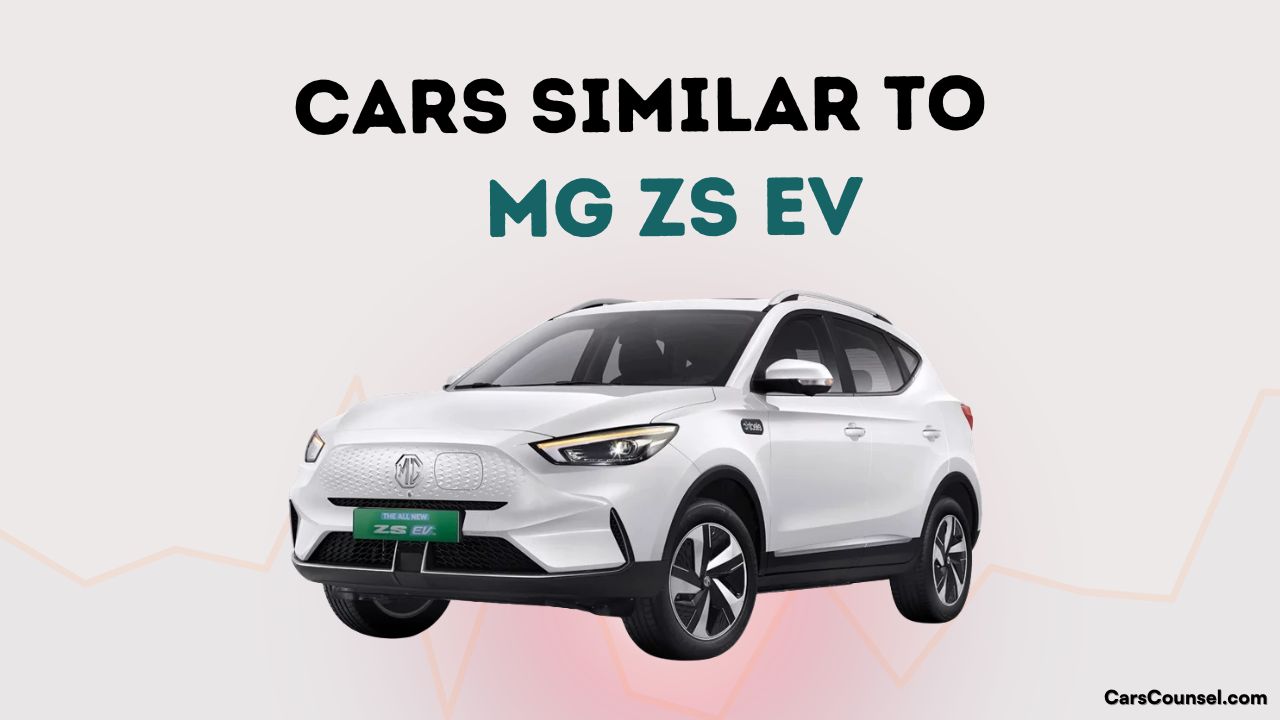Electric SUVs like the MG ZS EV offer an impressive range of up to 461 km and acceleration from 0 to 100 km/h in about 8.4 seconds, making them a practical choice in the compact EV segment. If you’re exploring alternatives, models such as the Tata Nexon EV, BYD Atto 3, and Mahindra XUV 400 EV provide varied features—from advanced safety to sportier performance and larger batteries—that could align with your needs. What sets these rivals apart beyond basic specs might influence your decision.

Quick Navigation
Key Takeaways
- The MG ZS EV is comparable to the Tata Nexon EV, with the MG offering 176 bhp and faster 0-100 km/h acceleration at 8.5 seconds versus Nexon’s 129-143 PS and about 9.9 seconds.
- Tata Nexon EV is priced lower (around Rs. 12.49-19.94 lakh) than MG ZS EV (about Rs. 17.99-21.58 lakh), appealing to budget-conscious buyers.
- Both MG ZS EV and Tata Nexon EV have similar battery pack sizes (~50.3 kWh vs 46.08 kWh) with real-world ranges near 250 miles and quick DC fast charging capabilities.
- Other competitors with comparable specs include BYD Atto 3, Mahindra XUV 400 EV, and Tata Punch EV, offering diverse battery sizes, power, and feature sets across the compact electric SUV segment.
- MG ZS EV stands out for its bold design, 5-star Euro NCAP safety rating, six airbags, and advanced tech, while Nexon EV emphasizes affordability and advanced safety features.
Overview of MG ZS EV Specifications and Performance
The MG ZS EV is powered by a 50.3 kWh lithium-ion battery paired with a permanent magnet synchronous motor that delivers 176 bhp and 280 Nm of torque, enabling it to accelerate from 0 to 60 mph in about 8.5 seconds.
It offers a real-world driving range of approximately 250 miles on a full charge, making it competitive for daily use. The vehicle supports both AC and DC fast charging, allowing you to recharge from 0 to 80% in roughly 40 minutes.
Safety is robust with six airbags, electronic stability control, and a 5-star Euro NCAP rating.
The MG ZS EV also provides a spacious interior with 448 liters of boot space for practicality.
Key Competitors in the Compact Electric SUV Segment
Several compact electric SUVs compete directly with the MG ZS EV, each offering distinct battery sizes, power outputs, and features to suit various needs.
The Tata Punch EV comes with 25 kWh and 35 kWh battery options, 122 bhp power, a 10.25-inch digital cockpit, and a 360° camera.
Tata Nexon EV, recently facelifted, features signature DRLs, a cinematic infotainment system, and 6 airbags.
BYD Atto 3, India’s first sporty-E-SUV, offers a 60.48 kWh Blade Battery and a 12.8-inch rotating touchscreen.
Mahindra XUV 400 EV accelerates in 8.3 seconds with 34.5–39.5 kWh batteries and six airbags, all tailored to compact electric SUV buyers.
Price Comparison Among MG ZS EV and Similar Models
Compact electric SUVs like the MG ZS EV offer competitive pricing to attract buyers seeking value in this segment. Priced at around Rs. 17.99 Lakh, the ZS EV stands strong among similar cars including the Tata Nexon EV and Curvv EV, both offering comparable prices and modern specs.
The BYD Atto 3 sits higher at Rs. 21.90 Lakh, reflecting its premium appeal. If you’re buying an electric car seeking cabin space and good real world range, these top competitors provide varied options.
The Tata Punch EV targets budget buyers, expanding choices in electric cars similar to the ZS EV.
Design and Interior Features of Comparable Electric SUVs
When comparing electric SUVs like the MG ZS EV, Tata Nexon EV, BYD Atto 3, Mahindra XUV 400, and Kia Niro, you’ll notice distinct differences in exterior styling, from sporty to bold and sleek designs.
Inside, cabin layouts and materials vary, with some models offering spacious, practical interiors and others focusing on premium finishes.
Infotainment and connectivity also stand out, ranging from physical controls for ease of use to large rotating touchscreens aimed at tech-savvy users.
Exterior Styling Comparison
The MG ZS EV commands attention with its bold, modern exterior, featuring a prominent front grille complemented by sleek, swept-back LED headlights that define its progressive SUV stance. In comparison, the Tata Nexon EV offers a rugged style with signature DRLs and unique backlighting. The Tata Punch EV adopts a compact, contemporary silhouette, while the Mahindra XUV 400 EV blends sporty and robust elements, illustrating diverse styling approaches in electric SUVs.
| Model | Front Design | Lighting Features |
|---|---|---|
| MG ZS EV | Bold grille, sleek LED headlights | Sleek LED headlights |
| Tata Nexon EV | Rugged, muscular front | Signature DRLs, backlighting |
| Mahindra XUV 400 | Sporty, robust stance | Modern LED headlamps |
Cabin Layout and Materials
Alongside exterior styling, the cabin layout and materials play an essential role in shaping your driving experience in electric SUVs like the MG ZS EV.
The MG ZS EV offers a sensibly designed interior with physical controls, premium synthetic leather, and a focus on comfort and practicality.
In contrast, the Tata Nexon EV impresses with a cinematic digital cockpit, creating a more immersive infotainment setup.
The BYD Atto 3 stands out with its 12.8-inch intelligent rotating touchscreen, while the Mahindra XUV 400 EV features a 10.25-inch HD display for advanced connectivity.
The Kia Niro adds a premium touch with upscale materials and a user-friendly design, elevating interior comfort.
Infotainment and Connectivity
Several electric SUVs competing with the MG ZS EV offer advanced infotainment and connectivity features that cater to modern drivers.
The MG ZS EV itself boasts a 10.1-inch touchscreen with Apple CarPlay and Android Auto, ensuring seamless tech integration.
The Tata Nexon EV improves your experience with a 10.25-inch digital cockpit, while the BYD Atto 3 stands out with a 12.8-inch rotating touchscreen for customizable control.
Mahindra XUV 400 EV provides a 10.25-inch HD infotainment screen, and Tata Punch EV adds safety with a 360° surround view camera, rounding out connectivity and tech integration options across these rivals.
Driving Experience and Efficiency Metrics
Though compact, the MG ZS EV delivers a smooth driving experience with its 143 bhp and 353 Nm torque, offering satisfying acceleration for everyday driving.
Its driving dynamics balance power and control, making city and highway trips comfortable. The vehicle achieves an efficient consumption rate of about 14.7 kWh per 100 km, reflecting strong energy use compared to traditional cars.
Regenerative braking aids efficiency by reclaiming energy during deceleration, extending range.
With flexible charging options—including home, AC, and DC fast charging—you can recharge conveniently, supporting both daily use and longer journeys without hassle.
Safety Features and Ratings in Rival EVs
Although the MG ZS EV boasts a 5-star Euro NCAP safety rating with features like six airbags, automatic emergency braking (AEB), lane-keeping assistance, and adaptive cruise control, several rival EVs offer comparable or improved safety technologies worth considering.
The BYD Atto 3 provides seven airbags and AEB, enhancing crash protection.
Tata Nexon EV and Mahindra XUV 400 EV both feature six airbags, while Tata Punch EV includes multiple airbags plus a 360° surround view camera.
These safety innovations guarantee competitive occupant protection and contribute significantly to the safety profiles of these EV rivals.
Ownership Costs and Warranty Considerations
When considering ownership costs for the MG ZS EV, you benefit from a strong 7-year or 150,000 km warranty that offers extensive coverage.
Maintenance and running costs tend to be lower than traditional vehicles, thanks to fewer moving parts and less frequent servicing.
Additionally, you can expect savings on fuel and insurance, making it a cost-effective choice in its segment.
Warranty and Coverage
You can expect the MG ZS EV to come with a comprehensive warranty of 7 years or 1,00,000 kilometers, which helps reduce potential repair costs during ownership.
Warranty insights reveal that many competitors like Kia Niro and Tata Nexon EV offer similar coverage, which impacts overall ownership costs.
Consider these points:
- The standard warranty usually includes the battery, often guaranteed for 8 years or 1,60,000 kilometers.
- Extended warranty options are available for added protection beyond the base period.
- Warranty terms may have exclusions and specific maintenance requirements.
- Understanding these terms helps avoid unexpected expenses during ownership.
Maintenance and Running Costs
The MG ZS EV’s maintenance and running costs are generally lower than those of traditional internal combustion engine vehicles, thanks to fewer moving parts and less frequent servicing requirements.
With a robust charging infrastructure, you’ll find electricity costs around ₹1.5-₹2 per kilometer, significantly cheaper than fuel.
The vehicle comes with a generous 7-year or 150,000 km warranty, covering battery degradation to maintain at least 70% capacity.
Government incentives may further reduce your ownership costs.
User Reviews and Market Reception of MG ZS EV Alternatives
How do alternatives to the MG ZS EV plunge up through the eyes of real drivers? User sentiment reveals diverse strengths across models:
- Tata Nexon EV and BYD Atto 3 win praise for advanced safety features and tech, appealing to you if you seek modern specs.
- Tata Punch EV stands out for affordability and practicality, with a 10.25-inch digital cockpit and 360° surround camera enhancing your experience.
- Mahindra XUV 400 EV attracts sporty SUV fans, boasting 0-100 km/h in 8.3 seconds, delivering performance you can feel.
- Kia Niro’s premium stance faces skepticism over range claims, while MG ZS EV users report better real-world efficiency.
Conclusion
The MG ZS EV stands as a well-rounded contender in the compact electric SUV segment, offering balanced performance, respectable range, and advanced tech features. Yet, competitors like the Tata Nexon EV, BYD Atto 3, Mahindra XUV 400 EV, and Tata Punch EV each bring their own strengths, from bigger batteries and sportier acceleration to budget-friendly options. Ultimately, choosing your ideal EV is like picking the right key to access your driving style—each fits the electric movement differently but effectively.

